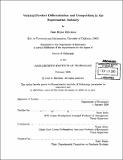Vertical product differentiation and competition in the supermarket industry
Author(s)
Ellickson, Paul
DownloadFull printable version (7.864Mb)
Other Contributors
Massachusetts Institute of Technology. Dept. of Economics.
Advisor
Scott Stern and Susan Athey.
Terms of use
Metadata
Show full item recordAbstract
This thesis examines the mechanisms by which retail markets converge to a concentrated structure where competition is dominated by only a few large firms. Using a model of competition based on the vertical product differentiation (VPD) enciogenous sunk cost framework proposed by Sutton (1991), several empirical implications are identified and evaluated using a detailed dataset of store level observations from the supermarket industry. Chapter 2 provides a formal test of the hypothesis that the high levels of concentration observed in the supermarket industry are the result of competitive investment in endogenous sunk costs. Using the bounds regression methodology developed in Sutton (1991), I document the existence of a large, positive lower bound to concentration that remains bounded above zero regardless of market size. This exercise is supplemented by a detailed case history of the industry that provides additional evidence that competition is focused on sunk outlays. In chapter 3, I expand the analysis by focusing on the local structure of competition. The principal contributions of the empirical work presented in this chapter involve identifying the high quality set of supermarket firms, demonstrating that they exist only in bounded numbers (do not increase proportionately with the size of the market), and identifying features of the observed market structure which are inconsistent with alternative explanations, namely by highlighting the distinctive nature of strategic complementarity. As such, I demonstrate that the VPD framework accords well with the combination of features observed in the supermarket industry, providing an accurate representation of the mechanisms sustaining its concentrated structure, which appear to be both competitive and stable. Three formal models of retail competition are presented in chapter 4, along with testable implications regarding the strategic interactions of rival firms.
Description
Thesis (Ph.D.)--Massachusetts Institute of Technology, Dept. of Economics, 2000. "February, 2000." Includes bibliographical references (leaves 130-137).
Date issued
2000Department
Massachusetts Institute of Technology. Department of EconomicsPublisher
Massachusetts Institute of Technology
Keywords
Economics.